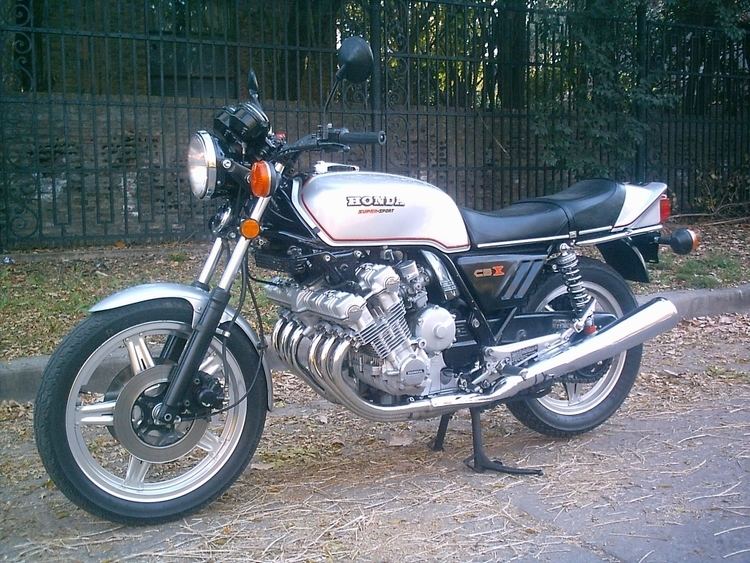Class Superbike | Production 1978–1982 Compression ratio 9.3:1 | |
 | ||
Bore / stroke 64.5 mm × 53.4 mm (2.54 in × 2.10 in) | ||
The Honda CBX was a sports motorcycle manufactured by Honda from 1978 to 1982. With a 1047cc inline six-cylinder engine producing 105 bhp (78 kW), it was the flagship of the Honda range. The CBX was well received by the press, but was outsold by its sibling, the Honda CB900F.
Contents
As a promotional exercise, CBX bikes were ridden by travelling marshals at the 1979 & 1980 Isle of Man TT.
Engine characteristics
Honda had produced a Honda RC series six-cylinder race bike in the mid-1960s, but the CBX was Honda's first production 6 cylinder road bike. The CBX's advanced DOHC 24-valve inline six-cylinder engine was its outstanding feature; but in other respects the bike was conventional, having telescopic forks, a tubular frame, twin rear shocks and straight handlebars.
Although bulky, the engine was wide only at the top. The width across the crankshaft was relatively narrow as the CBX had a stacked engine accessory arrangement, whereby the alternator and ignition items were positioned behind the cylinder block. This arrangement produced an acceptable engine width low down and moved critical items out of harm's way in the event of grounding.
Journalist L. J. K. Setright wrote of the CBX's width: "Don't tell me that its engine is too wide: It is no wider than the legs of a rider, so it adds nothing to the frontal area, and personally I would rather have my legs shielded by a cylinder apiece than exposed to every blow ..."
Sport touring model
In 1981, Honda repositioned the CBX into the sport touring category with the CBX-B, detuning the engine and adding Pro-Link monoshock rear suspension, air-adjustable 39 mm front forks, a fairing and panniers with a stronger frame to support these additions. The CBX was given beefier dual ventilated front brake discs to help bring to a stop the bike's increased weight. The 1982 model CBX-C model differed little from the 1981 model, having only some changes to paint and trim.
Reception
In the February 1978 issue of Cycle (magazine) editor Cook Neilson wrote this of a review of a pre-production bike. The objective-to build the fastest production motorcycle for sale anywhere in the world-has been met. From a four days review one at the Webco dynamometer and one split between American Honda, Orange County Raceway and with two at Willow Springs. Comparing the CBX to the CB900F, Setright added,"The CBX feels better and goes better, and the difference is greater than the difference in price, so the costlier bike is actually the better bargain. ... The CBX engine is as responsive as a racer, the nicest cycle motor to ever reach the street.".
The CBX was not the first production motorcycle to be powered by a six-cylinder engine (the first was the 1972–1978 Benelli 750 Sei, based on the Honda CB500 Four) but it was the latest and most advanced entry into the competitive superbike market. A review in Cycle magazine called the CBX a "breakthrough for the Japanese motorcycle industry" and praised its design, concept, and performance. The CBX was available on the market in late 1978, and the production model was even faster than the prototype.Cycle World got a tested 1/4 mile time of 11.64 seconds at 117.95 mph (189.82 km/h), the 1978 bike was also the first bike they tested to go over 130 mph (210 km/h). The 1979 CBX could cover a quarter mile in 11.36 seconds with a terminal speed of 189.82 km/h (117.95 mph). But later CBXs with the addition of saddlebags and a fairing were detuned, and showed the 1981 CBX had lost five hp compared to the 1978 model, from 105 hp down to 100 hp.
Cycle Guide praised the bike as "the Vincent Black Shadow of 1979" upon its introduction. In 2011, Australian publication 2 Wheels Magazine named the CBX as one of their favourite 12 superbikes ever.
To avoid confusion with Honda CBX series bikes, the CBX is sometimes referred to as the CBX1000.
